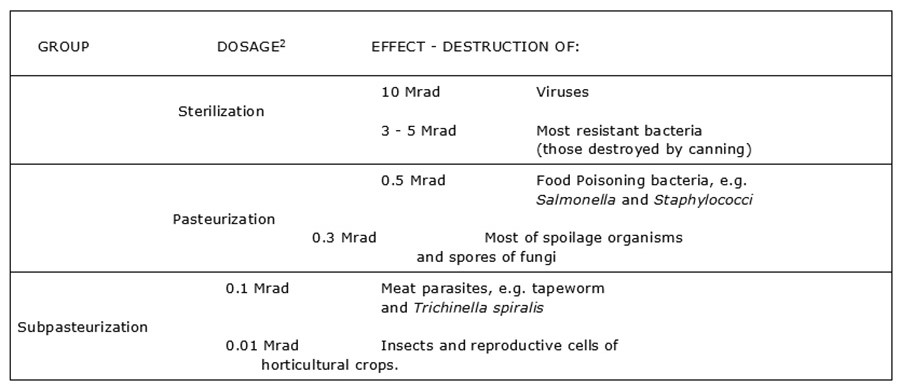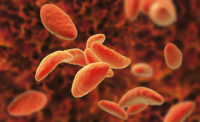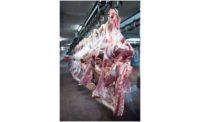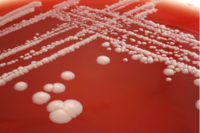Irradiation: The Research
Albert Einstein, Ph.D. was quoted as defining insanity as “doing the same thing over and over again and expecting a different result.”
For many decades scientists have studied Gamma irradiation of meat and poultry to ascertain whether that could be the Holy Grail for the preservation of freshness of meats and even destroy pathogenic microorganisms.
In 1963, we were given the opportunity to evaluate the use of Gamma irradiation to destroy bacteria on prepackaged poultry. The irradiation facility consisted of an 18,000-curie Cobalt-60 source in a shielded mobile irradiation trailer (Demonstrator, Atomic Energy of Canada Limited), through an arrangement with the U.S. Atomic Energy Committee. The dose rate was 5,000 rads/min. Ice packed and frozen chickens, were irradiated with 0, 0.1, 0.3, and 0.5 Mrads. (1 Mrad = 10 kGy). Increased irradiation levels resulted in greater decrease of viable surface bacteria. Irradiation increased shelf life of the poultry stored at 4.4C. We were not allowed to have our sensory panel taste the cooked chicken samples because the U.S. Food and Drug Administration (FDA) had not yet approved the safety of the procedure. Our panelists, however, were allowed to smell them and report their scores. The 0.3 and 0.5 Mrad samples had off-odors described as sour, spoiled, sweet, soapy, sharp, acrid, and musty. I recall some characterizations as “wet dog” and “burning chicken feathers.”
Other scientists, including Einar Risvik, Ph.D., (1983), reported beef and bacon irradiated at doses between 1 and 10 kGy had significant changes including off-taste, metallic taste, juiciness, and off-color. Now, five decades after our research cited above, scientists are still seeking methods to prevent the formation of off-odors in irradiated meat. Chae, et al. (2009) reported, “Irradiation increased the cardboard and painty aromatic attributes.” Brito et al. (2011) cited irradiation odors of mechanically deboned chicken irradiated with 0.32 kGy/h. In their study, the odor of irradiation was defined as, “Odor of burnt chicken skin after manual feather plucking the feathers are scorched over flame to facilitate the manual removal of feathers.” Thus, the irradiation odor of burnt chicken feathers in their study is the same as our original study 54 years ago, as referenced above.
After a few decades of study of Gamma irradiation of meat by scientists at universities, the U.S. Department of Agriculture (USDA), the Natick Army Research/Development Laboratory, and industry, neither the FDA, nor the USDA had approved the use of Gamma irradiation for the destruction of spoilage and pathogenic microorganisms on and in meat and poultry. Takeguchi, (1983), food safety officer at the FDA, said “However, food irradiation must not be used as a substitute for good sanitation practices.” The Natick Army Research and Development Laboratory spent more than $50 million dollars on irradiation research and finally transferred the responsibility to the USDA in 1980.
The military, the meat and poultry industries, and scientists have sought to understand the advantages and limitations of the use of irradiation to preserve meat and poultry from microbial contamination. Ronald E. Engle, D.V.M., Ph.D., deputy administrator for science at the USDA’s Food Safety and Inspection Service (FSIS), (1986), described the Department’s position on irradiation. He reported, “with low-dose irradiation of raw meat, the reported D-value, or 90 percent reduction value, for Salmonella spp. was 0.55-0.78 kGy, for Yersinia enterocolitica, 0.10-0.22 kGy, and Campylobacter jejuni 0.14-0.16 kGy. Therefore, even with an absorbed dose of only 100 Krad, there will be a 1.8-log reduction for Salmonella, a 10-log reduction for Yersinia, and a 7-log reduction for Campylobacter."
He also reported, however, “vacuum packaging combined with refrigerated storage at <5 degrees C is the preferred method for extending the shelf life of many perishable products, including pork. Vacuum packaging retards the growth of common aerobic spoilage bacteria, such as Pseudomonas spp., on refrigerated fresh meat, poultry, and fish. Low-dose (<1.0 kGy) irradiation has the potential of reducing competing microflora and thereby allowing Clostridium botulinum to flourish in the vacuum-packaged environment. Some strains of C. botulinum can produce toxins at temperatures as low as 3.3 degrees C., thus calling into question the value of cold storage of irradiated vacuum-packaged products. And, although the normal growth of C. botulinum causes a foul, putrid odor that should warn the consumer, spores of type E C. botulinum can produce toxins without sensory evidence of spoilage.
Table 1. A grouping of radiation-absorption dosages and their effects on living cells1

1Most of the information in this table is from Ingram and Rhodes, 1962, as presented in the review article by Kotula and Mercuri, (1974). 21 Mrad = 10 kGy
This table clearly indicates spoilage microorganism were destroyed at lower levels of irradiation than the levels required to destroy some potentially pathogenic microorganisms. Some individuals still dispute these results. If these data are accurate, then irradiation preferentially would destroy spoilage microorganisms, thus eliminating microbial competition, and fostering growth of potentially pathogenic microorganisms.
Irradiation: The Petition
Raltech Scientific Services, a Division of Ralston Purina, conducted 20 different studies related to the safety, toxicology and genetic research of irradiated meat (1983). The studies, funded by the USDA, included the toxicology and genetic histopathology of fruit flies, dogs and mice fed irradiated chicken treated with higher doses than those ultimately authorized by the FDA. Their studies lasted from 1976 to 1983. Their results demonstrated an increase in lesions, tumors and other concerns. Raltech Scientific Services concluded they could not recommend the irradiation of meat.
Tracor Jetco assessed the results of the studies and did not agree with the conclusions by Raltech Scientific Services, who conducted the studies.
A six-member panel, five from the Agricultural Research Service, and one from FSIS reviewed the Raltech results. Four members considered the results to be weakly supportive of irradiation. Two members of the panel considered the results to be “indeterminate and possibly slightly adverse” toward irradiation. They were concerned that a reduced production of offspring occurred among Drosophila melanogaster, who were reared on irradiated chicken. They observed that a dose response was evident. Additionally, survival of both sexes of mice was reduced in the group of mice fed irradiated chicken. The mice fed irradiated chicken also had the highest incidence of several tumors, and lesions, when compared to the controls. The panel then recommended that Tracor Jetco prepare a petition to the FDA (Contract 53-3K06-143), at an additional cost to USDA of $314,270 to be paid to Tracor Jetco.
Takeguchi, (1983), Food Safety Officer, FDA, quoted the standard of safety as “… reasonable certainty that no harm will result from the proposed use of an additive. It does not – and cannot – require proof beyond any possible doubt that no harm will result under any conceivable circumstances” (HR No. 2284, 85th Cong. 2d Sess. 1, 1958). Tageguchi (1983) stated, “One arduous avenue is to identify all the possible products formed during that process under all plausible conditions. However, this may be too costly and impossible to do.”
The USDA, being interested in methods to identify irradiated meat and poultry in the marketplace, supported research to find URPs, Unidentified Radiation Products, in irradiated chicken. Karam and Simic, National Bureau of Standards, found instead that irradiation converts phenylalanine into ortho-tyrosine, and that the increase of ortho-tyrosine in the insoluble fraction of irradiated chicken meat is linear. Ligon, (1986) suggested that URPs are formed, but not yet identified. He compared URPs caused by food irradiation, with the evolution of species that is caused by natural radiation, where URPs are called modified DNA.
At the request of the FDA, the National Toxicology Program’s Board of Scientific Counselors, U.S. Public Health Service, reviewed the Raltech’s histopathology data of mice fed irradiated chicken, (1985). They disagreed with Raltech’s conclusion that irradiated chicken fed to mice elicited a carcinogenic response. (see Table 2, below)
Table 2. Raltech data for mice fed irradiated chicken.
The FDA reviewed 409 toxicity studies on irradiated foods and “concluded that any chemical differences between foods irradiated at doses allowed by the regulations and non-irradiated foods are too small to cause concern about safety”. (See 51 FR 13379).
Thayer et al., (1987), reviewed toxicology studies of irradiated-sterilized chicken that were published between 1955 and 1983. He stated, “On the whole, the studies were consistent in producing negative results in all the variety of tests performed. There were however, some results that were difficult to explain on the basis of the available data. These were a) the unexplained reduction in the hatchability of the eggs of Drosophila reared on gamma-irradiated chicken. b) the poor survival of the virgin female mice fed irradiated chicken, c) the myocardial and glomerulonepropathy in mice that were fed irradiated chicken.”
On July 22, 1985, in response to a petition from Radiation Technology, Rockaway, NJ, the FDA approved irradiation of pork for the control of Trichinella spiralis (Federal Register, 1985). In that petition, Radiation Technology Inc. cited research that indicated Gamma rays penetrate meat, thus could destroy parasites such as Trichinella spiralis, within the meat. On 15 January 1986, the USDA approved irradiation, at doses from 0.3 to 1.0 kGy. (Federal Register 1986), for the control of Trichinella spiralis in pork carcasses, of fresh or previously frozen cuts of pork carcasses that have not been cured or heat processed. Pork, however, needs to be frozen to minimize the off-flavors and off-odors that occur when irradiated. Kotula, et al. (1990) demonstrated conditions under which freezing would destroy Trichinella spiralis in pork. Therefore, the freezing of pork is sufficient to kill Trichinella spiralis without the irradiation step.
Lingering questions:
One may then question why irradiate frozen pork when the Trichinella are already dead? One may wonder why irradiate meat to destroy microorganisms, when Takeguchi, indicated irradiation should not be used as an alternative to good manufacturing practices to reduce bacterial contamination. One may wonder whether consumers (and therefore the companies that provide products for those consumers) would want products with poor quality (objectionable off-odors and off-flavors) and questionable safety. One may also wonder whether this petition process raises any other concerns.
References:
Brito, P.P., H. Azevedo, K.M.V.A. Cipolli, H.T. Fukuma, G.B. Mourao, C.V. Roque, N. Miya, and J.L. Pereina, 2011. The effect of gamma radiation dose rate on psychrotrophic bacteria, thiobarbituric acid reactive substances, and sensory characteristics of mechanically deboned chicken meat. Journal of Food Science 76:(2):133-138.
Engle, R.E., 1986. The International Consultative Group on Food Irradiation, Task Force Meeting on the Use of Irradiation to ensure Hygienic Quality of Food, Vienna, Austria, July 14-18.
Federal Register, Rules and Regulations. 1985, 22 July. Vol. 50. 29658
Federal Register, Rules and Regulations. 1986.15 Jan. Vol. 51 No. 10.
Federal Register, Rules and Regulations. 1987. 23 February. Vol. 52. No. 35.
Ingram, M. and D.N. Rhodes, 1962. Progress in food irradiation. Food Manufacture 37:(7):318-326, 338.
Karam, L.R., and M.G. Simic, 1988. Ortho–tyrosine as a marker in post-irradiation dosimetry (PID) of chicken. In: Health impact. Identification and dosimetry of irradiated food. Report of WHO Working Group. Bogl K.W., Regulla D..F, Suess M.J., editors. Neuherberg /Munich Nov. 17–21. 1986. Copenhagen: WHO. p 297–304.
Kotula, A.W. and A.J. Mercuri, 1964. Food preservation by gamma irradiation. A Review. The Maryland Poultryman. pp 1-5.
Kotula, A.W., A.K. Sharar, E. Paroczy, H.R. Gamble, R.B. Murrell, and L. Douglas, 1990. Infectivity of Trichinella spiralis from frozen pork. J. Food Protection. 53:(7):571-573.
Lingon, W. Irradiated Food. 1987. Industrial Chemist. Editor’s Desk. p 4
Mercuri, A.J., A.W. Kotula, and D.H. Sanders, 1967. Low-dose ionizing irradiation of tray-packed cut-up fryer chickens. Food Technology 21:(11):95-98.
National Toxicology Program Board of Scientific Counselors. Final Summary Minutes for the “Peer Review of the Data from the Raltech Lifetime Feeding Study with Irradiated Chicken Meat in CD-1 Mice by the Technical Reports Review Subcommittee and Panel of Experts.” Held at Research Triangle Park. NC. March 28, 1985.
Ralston Purina Co., 1983. “Final Report: A Chronic Toxicity, Oncogenicity, and Multigeneration Reproductive Study Using CD-1 Mice to evaluate Frozen, Thermally Sterilized, Cobalt-60 Irradiated, and 10 MeV Electron Irradiated Chicken Meat.” Report to U.S. Department of Agriculture. Agricultural Research Service, June 1983.
Risvik, E., 1983, Norwegian Food Research Institute. Personal communication.
Takeguchi, C., 1983. Regulatory aspects of food irradiation. Food Technology, 37:(2): 44-45.
Thayer, D.W., J.F. Christopher, L.A. Campbell, D.C. Ronning, R.R. Dahlgren, G.M. Thomson, and E. Wierbicki. 1987. Toxicology studies of irradiation-sterilized chicken. J. Food Protection, 50:(4):278-288.
[Modified from the Phi Tau Sigma Newsletter, Interesting Forgotten Research, May 2012 and June 2012]




Report Abusive Comment